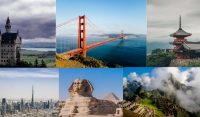For a long while, Google’s AI research division has been on a mission to grow capable of accurate instance-level landmark recognition and retrieving images — both widely recognized as extremely difficult. To that effort, last year, it released its Google-Landmarks dataset and hosted two competitions for more than 500 machine learning researchers. Last week, it went a step further with the release of its open-sourced Google-Landmarks-v2, which contains double the photos featuring seven times the landmarks.
To break down the capabilities of each desired function, VentureBeat writes that instance-level landmark recognition would allow for distinguishing “Niagara Falls from just any waterfall” while retrieving images would allow for the matching of “objects in an image to other instances of that object in a catalog.”

In addition to unveiling v2, Google also launched two new challenges: Landmark Recognition 2019 and Landmark Retrieval 2019 on its machine learning community, Kaggle. The company also “released the source code and model for Detect-to-Retrieve, a framework for regional image retrieval,” reports TechCrunch.
“Both instance recognition and image retrieval methods require ever-larger datasets in both the number of images and the variety of landmarks in order to train better and more robust systems,” wrote Google AI software engineers Bingyi Cao and Tobias Weyand on the Google AI Blog. “We hope that this dataset will help advance the state-of-the-art in instance recognition and image retrieval.”
In total, Google-Landmarks-v2 boasts more than 5 million images of over 200,000 landmarks. Photographers labeled their own images and submitted them to Google for inclusion in the dataset. Afterward, the Google team “supplemented them with historical and lesser-known images from Wikimedia Commons, the Wikimedia Foundation’s online repository of free-use images, sounds, and other media,” notes TechCrunch.
Landmark Recognition 2019 and Landmark Retrieval 2019 offer cash prizes totaling $50,000 and winning teams will present their methods at the Second Landmark Recognition Workshop at the 2019 Conference on Computer Vision and Pattern Recognition.

No Comments Yet
You can be the first to comment!
Sorry, comments for this entry are closed at this time.